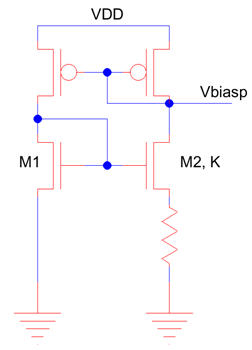Bad Circuit
Design 4 - Self-Biased References
We
used the beta-multiplier reference (BMR) seen below throughout the book to
provide biasing
for
our analog circuits (see the nano-CMOS version in Fig. 20.22). We use this
topology because
it
provides ďsupply independent biasing.Ē Further, as indicated on page 625 the gm of the
MOSFETs
can be controlled. The threshold voltage of M1 and M2 subtract out (donít
affect the
bias
current) making the BMR work well with process shifts. Finally, the decrease in
the MOSFETís
mobility
with increasing temperature is compensated by the increase in the resistorís
value (see Eq.
[20.37])
making the BMR-generated reference current stable with temperature.

There
are other self-biased references that can be implemented in a CMOS process. For
example,
the
circuit seen below is a threshold voltage-referenced self-biasing circuit. M1
is made relatively
wide
so that itís gate-source voltage is a threshold voltage. The current that flows
in either side is then
VTHN/R.
Why is this a bad design for providing MOSFET biasing? It is supply independent biasing
afterall. Well, first off notice that as
temperature increases the threshold voltage drops and the
resistor
value goes up resulting in the current having a large negative TC. Next, notice
that the
threshold
voltage doesnít subtract out (this is a big problem). The result is the MOSFET
biasing
conditions
will vary all over the place with process, temperature, and voltage shifts.
Donít use this
circuit
for biasing. Itís bad design! Use
the BMR.

Other
examples of self-biased reference circuits are the diode-referenced self-biased
circuit (Fig. 23.22)
and
the thermal voltage referenced self-biased (Fig. 23.24). The MOSFET threshold
voltage doesnít
affect
the operation of these circuits and the diode forward voltage drop doesnít vary
a significant amount
so
why arenít these good circuits to provide biasing. To begin, the
diode-referenced bias circuit has a
large
negative TC (diodeís forward drop decreases with increasing temperature while
the resistorís value
goes
up with increasing temperature). Why this (large negative TC) is undesirable,
the fact that the
referenceís
current isnít directly related to any MOSFET parameters doesnít result in
stable biasing
conditions.
The latter point is also applicable to the thermal-voltage referenced
self-biasing circuit (though
this
reference has a better TC).